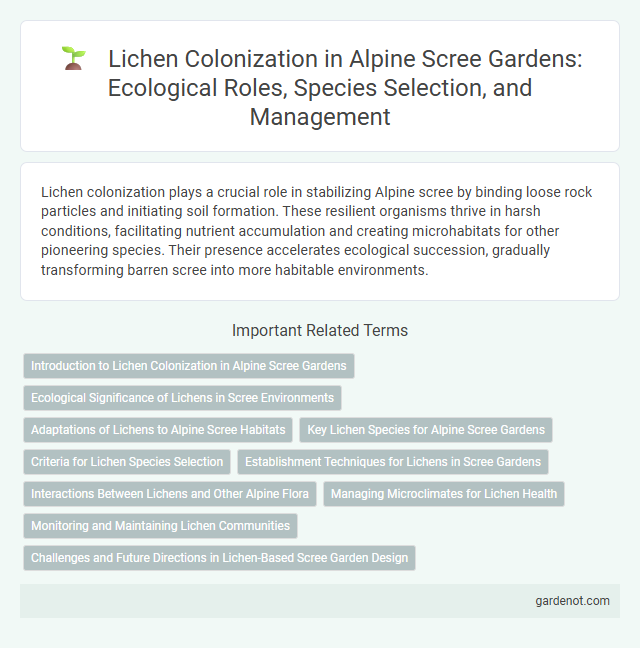Lichen colonization plays a crucial role in stabilizing Alpine scree by binding loose rock particles and initiating soil formation. These resilient organisms thrive in harsh conditions, facilitating nutrient accumulation and creating microhabitats for other pioneering species. Their presence accelerates ecological succession, gradually transforming barren scree into more habitable environments.
Introduction to Lichen Colonization in Alpine Scree Gardens
Lichen colonization in alpine scree gardens plays a crucial role in ecosystem development by stabilizing loose rock substrates and initiating soil formation. These symbiotic organisms, composed of fungi and algae or cyanobacteria, tolerate extreme conditions such as low temperatures, high UV radiation, and limited nutrients. Their ability to adhere to bare surfaces and slowly accumulate organic material creates microhabitats that support further plant succession and biodiversity in harsh alpine environments.
Ecological Significance of Lichens in Scree Environments
Lichen colonization in alpine scree contributes significantly to ecosystem stability by binding loose rock fragments and reducing erosion. These symbiotic organisms facilitate soil formation through biochemical weathering, enabling the establishment of other plant species in nutrient-poor environments. Their presence enhances biodiversity and supports microhabitats essential for invertebrates and microbial communities in scree ecosystems.
Adaptations of Lichens to Alpine Scree Habitats
Lichens colonizing alpine scree exhibit specialized adaptations such as tolerance to intense UV radiation, desiccation, and extreme temperature fluctuations typical of high-altitude environments. Their ability to anchor to unstable, nutrient-poor rocky substrates through specialized holdfast structures ensures survival in constantly shifting scree. Symbiotic relationships between fungal and photosynthetic partners enable lichens to efficiently utilize scarce moisture and nutrients, promoting resilience in harsh alpine scree habitats.
Key Lichen Species for Alpine Scree Gardens
Key lichen species for Alpine scree gardens include Rhizocarpon geographicum, Xanthoria elegans, and Cetraria islandica, which demonstrate exceptional adaptation to harsh, nutrient-poor environments. These lichens stabilize scree substrates and contribute to early soil formation, facilitating the establishment of vascular plants. Their presence indicates ecosystem resilience and plays a crucial role in biogeochemical cycling within alpine scree habitats.
Criteria for Lichen Species Selection
Lichen species selection for colonization on alpine scree depends primarily on their tolerance to extreme temperature fluctuations, high UV radiation, and limited nutrient availability. Species with efficient water retention mechanisms and a strong symbiotic relationship between fungi and algae show higher colonization success. Preference is also given to lichens capable of rapid growth and substrate stabilization to withstand the dynamic scree environment.
Establishment Techniques for Lichens in Scree Gardens
Lichen colonization in alpine scree gardens relies on specialized establishment techniques such as rock preparation and inoculum application to enhance attachment and growth. Techniques like spraying or brushing lichen slurry onto stable rock substrates mimic natural dispersal while promoting early symbiotic development between fungi and algae. Ensuring microhabitat suitability through moisture retention and shade optimization increases lichen survival rates and accelerates ecological succession in harsh scree environments.
Interactions Between Lichens and Other Alpine Flora
Lichen colonization on alpine scree plays a crucial role in ecosystem development by stabilizing rocky substrates and facilitating soil formation. These symbiotic organisms interact closely with pioneer vascular plants, often enhancing nutrient availability through nitrogen fixation and creating microhabitats that support seedling establishment. Such interactions accelerate primary succession, promoting biodiversity and resilience in harsh alpine environments.
Managing Microclimates for Lichen Health
Managing microclimates in alpine scree environments is critical for promoting lichen colonization and health, as lichens are highly sensitive to temperature fluctuations, moisture levels, and sunlight exposure. Techniques such as controlling shading through natural vegetation buffers and optimizing substrate moisture retention can create stable conditions that support lichen growth. Monitoring microclimate variables like relative humidity and soil temperature enables targeted interventions to sustain resilient lichen communities in harsh alpine scree habitats.
Monitoring and Maintaining Lichen Communities
Monitoring lichen colonization on alpine scree involves systematic surveys to assess species diversity and health using GPS mapping and photographic documentation. Maintaining lichen communities requires minimizing disturbances such as trampling and erosion by establishing protected zones and promoting soil stabilization techniques. Regular monitoring data inform adaptive management strategies to support resilient lichen populations in harsh alpine environments.
Challenges and Future Directions in Lichen-Based Scree Garden Design
Lichen colonization on alpine scree faces significant challenges such as extreme temperature fluctuations, limited nutrient availability, and mechanical instability of the substrate, which hinder their establishment and growth. Future directions in lichen-based scree garden design focus on selecting resilient species with high tolerance to abiotic stressors and developing substrate stabilization techniques that promote lichen adhesion and moisture retention. Innovative approaches integrating microhabitat engineering and symbiotic microbial inoculation are essential for enhancing lichen survival and ecological function in these harsh environments.
Lichen colonization Infographic

 gardenot.com
gardenot.com